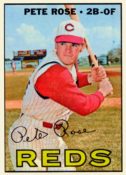“The strongest thing baseball possesses today is its yesterdays."
Lawrence Ritter
Good news! Baseball cards are alive and well in the 21st century.
In his over 40 years in the hobby, Mark Rubin of American Legends has witnessed some extraordinary changes in the industry. The first was the error card craze that began with the 1979 Topps Bump Wills variation and culminated with the 1981 Fleer Craig Nettles error card. In 1981, the hobby made headlines when Donruss and Fleer joined Topps to produce baseball cards. The Topps monopoly had been shattered and it was big news.
Shortly after, rookie card speculation and vintage cards dominated the market. Soon collectors were feverishly chasing Don Mattingly, Darryl Strawberry and Eric Davis rookies. Fortunately, they also pursued Mickey Mantle, Willie Mays and Babe Ruth cards. With the meteoric rise in the price of vintage cards, treasure hunters went through their attics searching for cardboard gold. With all the great items hitting the market, both new and old, the frenzy fed off of itself.
In 1989, Upper Deck joined the field of manufacturers and ushered in the era of high-end products. Within a few years, premium products such as Stadium Club and Finest pushed the envelope in technology and desirability. After the shakeout from the 1994 baseball strike, thousands of collectors returned to the hobby in 1998 to follow the home run heroics of Mark McGwire and Sammy Sosa.
In fact, baseballs resurgence led to a hobby boom in the late 1990s. Game-used jersey cards and autographs became regular inserts into unopened packs. For the past decade, even in modern products, vintage has been the name of the game. Manufacturers have produced reissue cards in the styles of the 1950s and 1960s featuring current players to try to peel off some of the vintage demand. And in the past 15 years, sales of the crown jewel of baseball cards, the T206 Honus Wagner have skyrocketed from $500,000 to $6.6 million.
Memorabilia also saw tremendous changes during this period. Upper Deck Authenticated introduced the matching hologram and certificate of authenticity giving collectors confidence that their items were genuine. Vintage autographs have also soared in popularity as 3rd party authenticators such as PSA/DNA and James Spence (JSA) provided assurance for previously signed items.
In just the last few years, the booming economy has brought many investors, hedge-fund collectors & speculators as well as well heeled millennials into (and back into) the sports card marketplace. And with the pandemic, lapsed collectors of the 80s and 90s searched for their old card collections and discovered the joy of collecting (and investing) once again.
So where does that leave the collector in 2024 and beyond? As we always tell our customers at American Legends, buy what you like, not what you think is going to be valuable. Whether it’s a single card, a complete set or a memorabilia/signed item, if you like it, it will always maintain its value.

Get an immediate offer that is fair, straightforward and maximizes the value of your entire collection.
Learn more about what makes American Legends the best place to sell your sports cards.

“It's hard to beat a person who never gives up."
Babe Ruth